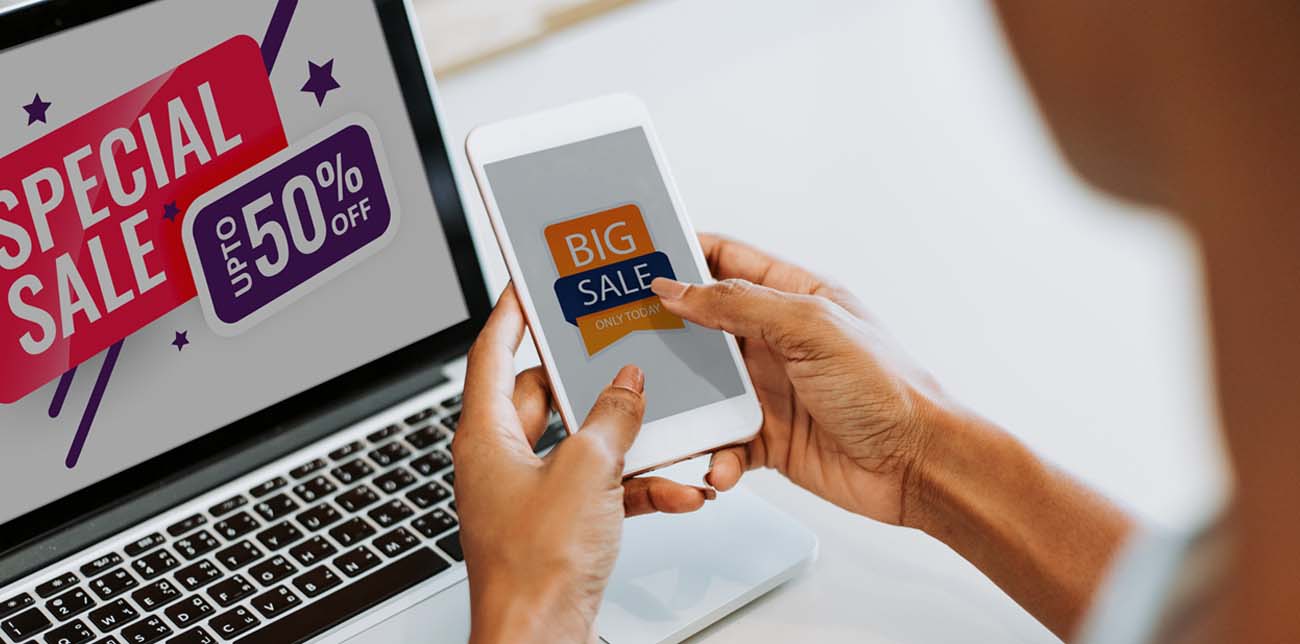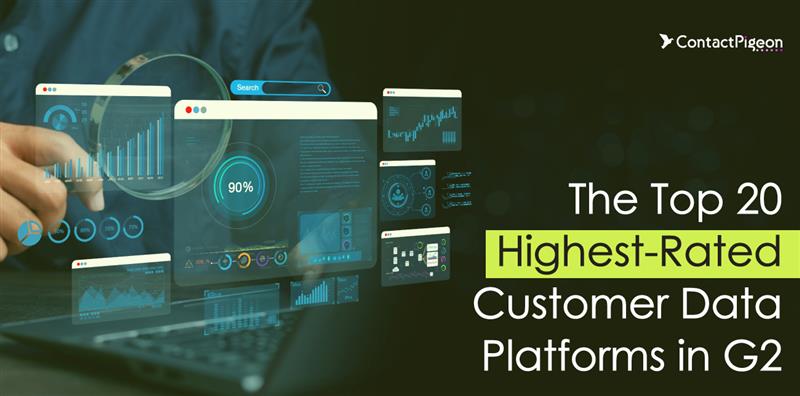Robust marketers are tapping into the latest omnichannel eCommerce trends to grow retail sales year over year.
How can you create an omnichannel eCommerce marketing strategy for your brand? We’ve got you covered. In this post, we’ll go into why omnichannel eCommerce is the future, and how to get started with omnichannel marketing.
Table of Content
- Amazon, again, leads the way
- What is Omnichannel eCommerce Marketing?
- Omnichannel vs Multichannel eCommerce
- Benefits of Omnichannel eCommerce Marketing
- eCommerce omnichannel trends worldwide
- 2 great Omnichannel eCommerce examples to get inspired from
- Designing your Omnichannel Strategy in 2021
- An Omnichannel approach is the only way
Amazon, again, leads the way
Even brick and mortar brands use omnichannel eCommerce strategies to promote their brand across all available channels. Take Amazon for example. The brand connects the offline and online channels seamlessly using their Amazon 4-Star store. Thereby improving brick and mortar customer experience with online data.
How did they do it?
The Amazon 4-Star store is a physical extension of Amazon.com. It showcases products based on customer data collected. Furthermore, are three primary sets of data Amazon uses to curate items to display in this unique physical store:
- Reviews – Every item in the store is selected only if it has 4-stars and above rating.
- Sales Data – Amazon identifies the top selling items online. Then, according to the omnichannel supply chain eCommerce data, they stock stores and keep inventory turnover high.
- Customer Data – Data collected identifies trending products. “Most Wished For” and “Frequently Bought Together” are displayed together in the physical store.
This Amazon case study demonstrates how even the biggest online brands are using omnichannel eCommerce solutions to develop offline presences. This is why every marketer needs to perfect his optimization skills on key channels like Amazon and more importantly, to deepen his/her skills and knowledge on how to create a 360 omnichannel marketing strategy. You need your brand to be everywhere, creating a unified brand experience.

Amazon 4-Star Store is a visual omnichannel eCommerce definition —
What is Omnichannel eCommerce Marketing?
Omnichannel eCommerce marketing refers to using all available channels for marketing purposes. This is a fully-integrated approach to marketing ensures shoppers experience a seamless buyer’s journey across touchpoints. Whether online or offline, mobile or desktop, shoppers are effortlessly engaged with your brand.
Examples include using an omnichannel eCommerce software to reach your audience via email, push notifications, phone, SMS, social media, TV adverts, paper brochures, and so on.
For marketers, the ultimate goal of omnichannel marketing is to reach shoppers. You want to create real-time oversight at each customer touchpoint of the buyer’s journey. Luckily, omnichannel marketing takes the guesswork out of creating a more personalized and tailored marketing campaign.

Omnichannel eCommerce meaning: Use an omnichannel eCommerce marketing strategy to reach your audience via email, push notifications, phone, SMS, social media, TV adverts, paper brochures, and so on.
Omnichannel vs Multichannel eCommerce
Current omnichannel eCommerce statistics show that multi-channel marketing strategies are a thing of the past. While eCommerce trends show that omnichannel marketing is the way of the future.
The difference between multichannel vs omnichannel eCommerce marketing is very distinguishable. “Multi” means “many”, while “Omni” means “all”. However, this doesn’t apply to the marketing channels. In fact, it applies to the marketing approach. Here’s how they differ:
Multichannel marketing
- A marketing approach where channels operate largely in isolation
- Customer data — both offline and online — is stored in separate databases
- Users have a hierarchical access to data
Omnichannel Marketing
- Channels operate with centralized data and decentralized use
- Tracking data at all customer touchpoints
- A personalized, automated customer experience
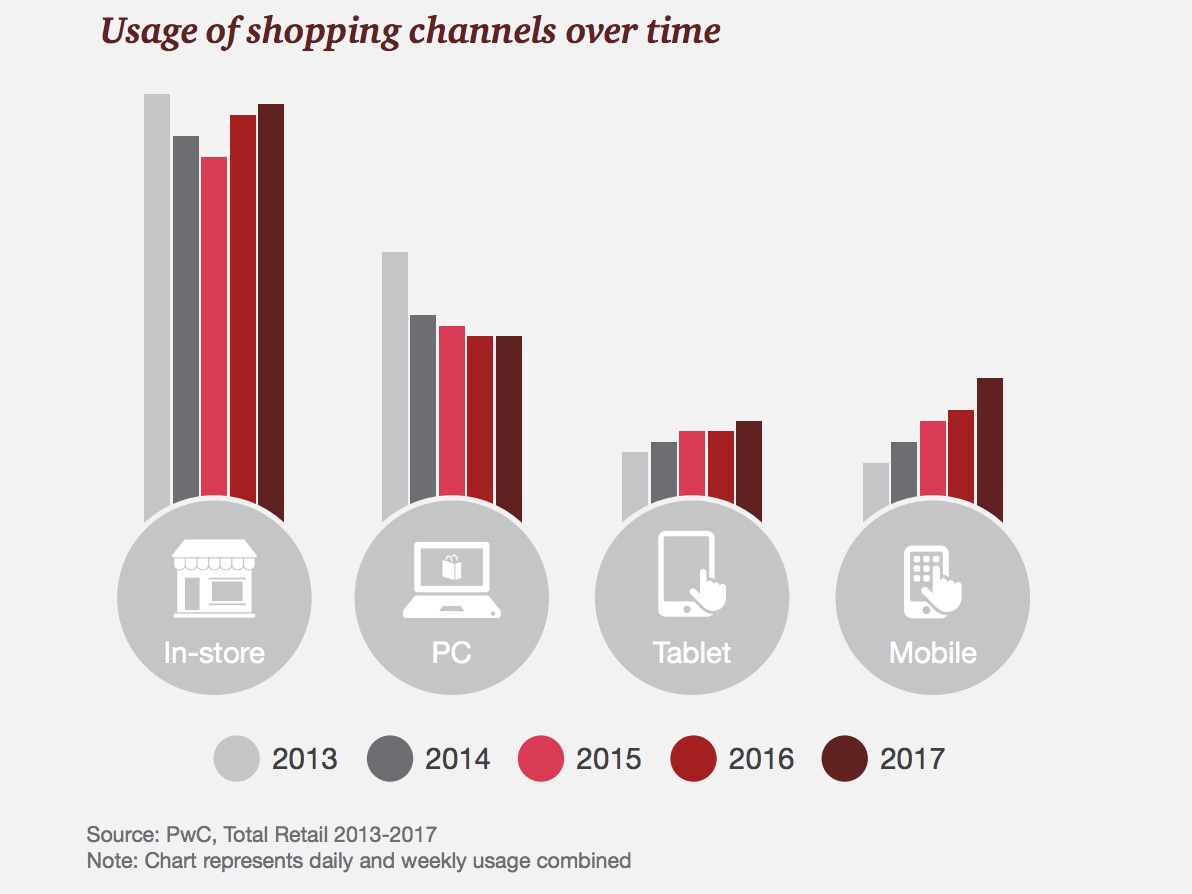
Consumers are increasing the various channels they use to purchase. Whether online or offline, mobile or desktop, shoppers are effortlessly engaged with your brand with omnichannel marketing.
Omnichannel marketing has a direct impact on the customer lifecycle. However, it is also a resource that optimizes all stages of the buyer’s journey. The data generated by omnichannel eCommerce marketing and automated marketing helps contribute to building positive experience across all channels. Thus, omnichannel eCommerce marketing creates an awesome relationship between your customer and brand.
Benefits of Omnichannel eCommerce Marketing
There are many benefits to harnessing the power of combining eCommerce and omnichannel retail strategies.
One benefit of omnichannel marketing is whether shoppers are online and move offline, etc, there is a unified experience across channels. Here are some examples that highlight the importance of omnichannel in eCommerce. Now, let’s look at how it will help you grow your brand:
Extend your presence
As Amazon demonstrates, omnichannel marketing benefits retailers by creating a virtual extension connecting brick-and-mortar stores to eCommerce marketplaces. Also, they connect and mobile-browsing to onsite storefronts.

Amazon uses brick and mortar stores to expand their presence and gather valuable data.
A recent HBR study shows that the majority of consumers today take every variable path possible when it comes to shopping journeys. Of the 46,000 customers surveyed, the study revealed:
- 7% exclusively shopped online
- 20% exclusively shopped brick and mortar
- 73% used multiple channels
Consider estimates that by 2040, 95% of all purchases will be online purchases. What does this mean for retail marketers? You need to use an omnichannel eCommerce strategy vs one-channel or even multichannel marketing. This way, you will create consistent engagement between buyers and your brand.
Increase conversions
Also, the same study showed the more channels a customer uses, the more they spend. Omnichannel retail customers spent an average of 4% more each time they shop in-store. Furthermore, they spent an average of 10% more online than single-channel customers.
Turn buyers into loyal customers
When done correctly, omnichannel marketing creates a seamless journey for shoppers. This allows buyers to transition from one channel to the next with actions that aren’t forced. In turn, by inviting buyers to take actions that feel native, they become increasingly engaged with your brand. Furthermore, they do so without even realizing it! The end result? Omnichannel marketing helps buyers evolve to loyal customers.
eCommerce omnichannel trends worldwide
More and more consumers are turning to eCommerce for convenient online shopping.
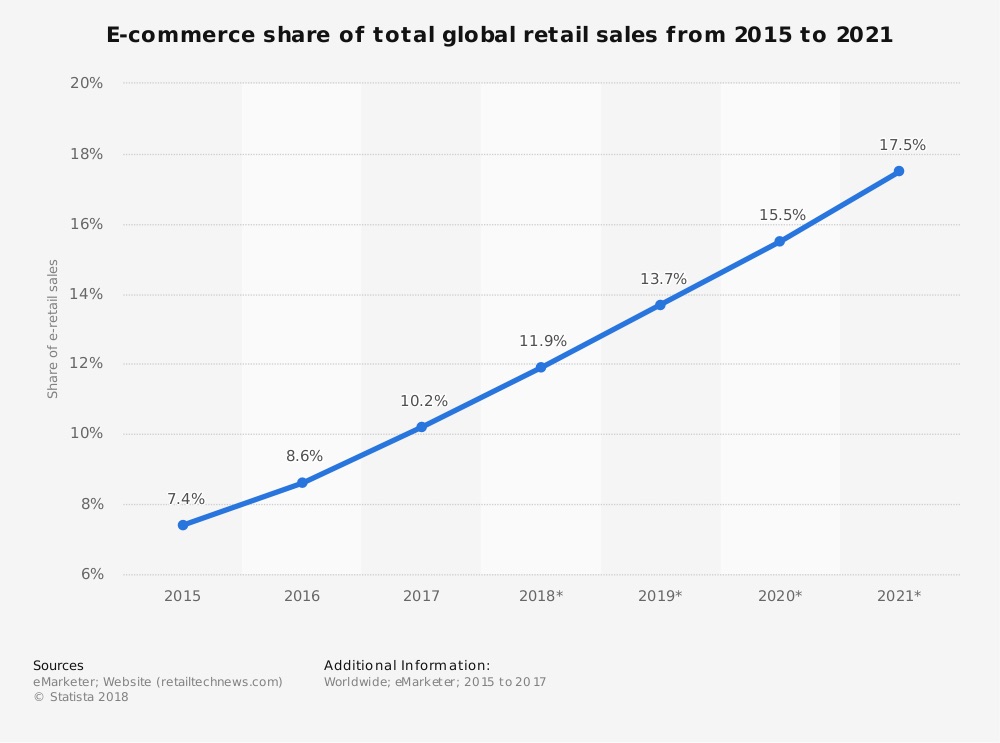
Global eCommerce retail sales are skyrocketing, year after year.
Also, savvy marketers need to figure in one other vital component influencing shoppers worldwide. The mobile trend and the growing usage of smartphones and tablets.
Omnichannel eCommerce retail growth
The global omnichannel retail eCommerce platform market is expected to grow. A lot. In fact, from 2017 it’s predicted to grow from USD 2.99 billion to USD 11.01 billion by 2023. The Asia-Pacific region is the fastest growing region worldwide. This is thanks to the large eCommerce market and growth in popularity of the click and collects system.
According to Statistica, in 2017, 22% of eCommerce retailers in North America listed omnichannel marketing as a top digital business priority. Furthermore, the same survey revealed that 46% said marketing was their top priority. And, at the top of the list was mobile at 54%.
Since 90% of users move between devices during the customer journey, focusing on mobile and other devices is key to marketers’ success. However, online purchases are not the only reason why you need an omnichannel marketing strategy.
Consider 80% of shoppers begin their journey researching online and end up purchasing in-store. Not to mention, despite the rise in popularity of eCommerce, 90% of sales globally still take place offline. Lastly, is a must-mention show-stopping eCommerce omnichannel trend. Omnichannel customers spend 208% more than direct in-store shoppers!
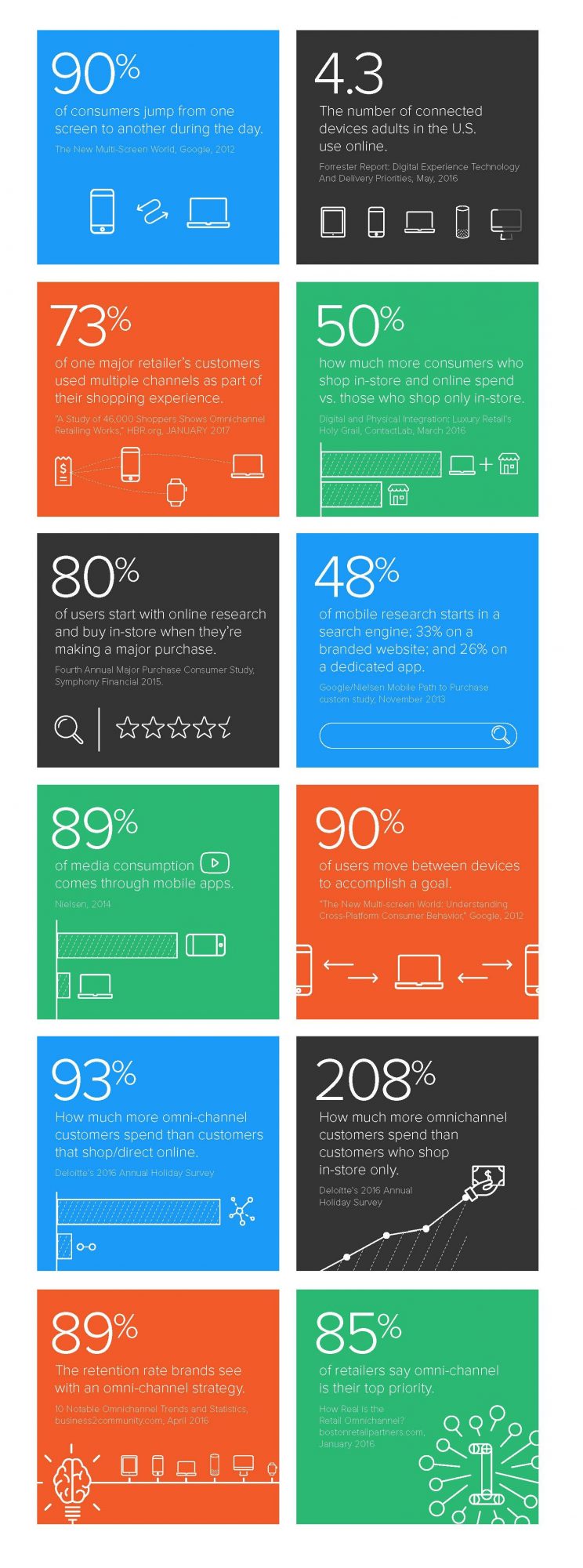
Source: info.localytics.com
Collecting data: trends in omnichannel eCommerce in US/UK
In the US most consumers say they would opt out of data collection if they could. However, in the UK, consumers like the conveniences that sharing their web behavior brings more than the concerns of giving up some privacy.
According to a BigCommerce study, UK consumers do not request to have companies stop collecting their data.
North America is the leader when it comes to setting the growth trends of omnichannel marketing. This is due to the high level of digitization and growing online sales.
Now, let’s look at some Omnichannel eCommerce examples to get you inspired.
2 great Omnichannel eCommerce examples to get inspired from
Omnichannel retail campaign example #1: Crate & Barrel
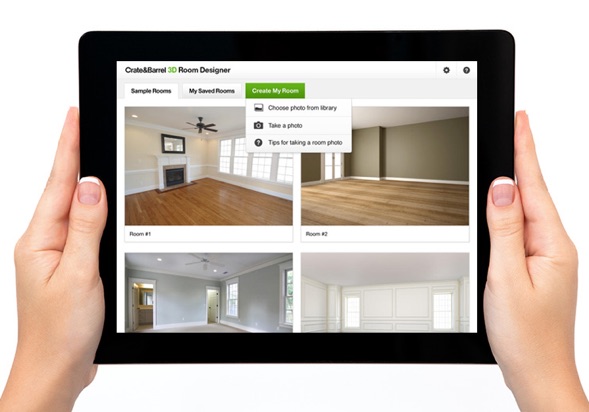
Concept: Implementing an omnichannel customer experience strategy. No matter what device a shopper who is logged into their account is browsing with, Crate &Barrel’s app saves their shopping cart and browsing data. Also, their omnichannel eCommerce platform allows shoppers to create their room’s look!
Channels included: Mobile and desktop
Why we love it: Shoppers are able to access their shopping cart and browsing data information across multiple devices. They can “try out” items before purchasing them using their virtual platform.
Results: Omnichannel marketing allows consumers to take up where they left off in the shopping process. This omnichannel customer experience strategy resulted in a 10% revenue increase for Crate & Barrel’s mobile and web stores.
Omnichannel retail example #2: Sephora
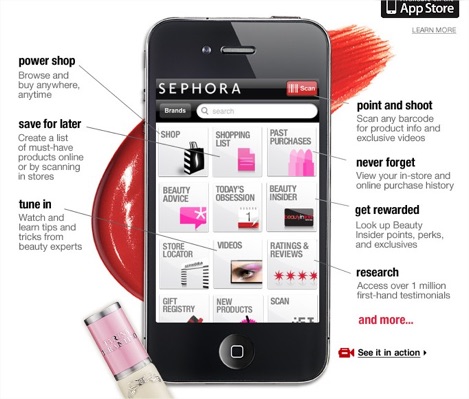
Concept: Offline scanning converts to online information. Sephora Beauty Insiders shoppers can scan items while in-store to see other options available online. They can also access tutorial beauty videos.
Channels included: Mobile and desktop
Why we love it: Great for customer experience and an awesome way to gather data for marketers. The scanned data can be used by Sephora creates a solid profile of the customer. Furthermore, marketers can see product interest, store visited, and device used. This makes a more personalized and valuable shopping experience for the customer. That is because the information can be used for further remarketing via email, paid ads, etc.
Results: This omnichannel eCommerce marketing strategy nurtures the needs of over 11 million members. These shoppers, in turn, spend 15 times more money on Sephora.com than the average user.
Tip: If you want to dive deeper into Sephora’s omnichannel strategy take a look at our 3.3k words-long case study.
Designing your Omnichannel Marketing Strategy in 2023
The concept of omnichannel eCommerce marketing sounds great. However, it can be extremely challenging to do well. There are some complexities when it comes to the operational side of things.
Marketing wise, many companies pursuing this strategy need to overcome the major challenges of:
- Synchronization of data across channels when it comes to driving consumer insights, tracking activities and measuring results, and
- Unifying campaigns across platforms
The solution to these challenges? First off, emulate the examples of successful omnichannel eCommerce examples above. Next, adopt a well-structured technology architecture and understanding of various touchpoints your business has with consumers. Here are some tips for developing a successful omnichannel eCommerce marketing strategy:
Integration of data across channels
This is by far the biggest challenge of all for eCommerce marketers. Particularly, the integration of data across all offline and online channels.
As customers interact with your brand across channels, how can you capture these interactions? You need to gain insights into customer behaviors, campaign outcomes, etc. How? With access to a unified view of the customer (aka single customer profile), data integration across enterprise platforms, and cross channel analytics and reporting.
Map out all potential touchpoints within a consumer journey starting from awareness to conversion. For each touchpoint, consider the types of data you’d like to gather. Then, link your CRM with ongoing on-site retargeting campaigns. As a result, you can maximize the outcomes for data synchronization to aggregate the data points across the journeys.
Tip: Use CRM.
Nail your customer(s) journey
Start by harnessing the power of omnichannel marketing with marketing automation. This is a great tip on how you can define customer journeys and how customers interact with your brand at every touchpoint.
Next, identify where your customers are most active. Also, take note of how you continue to engage them within specified channels.
Then, get started in defining ideal customer journeys across channels. Group customers according to previous web behaviors and actions to target shoppers with personalized relevant copy.
Furthermore, you can also set up specific parameters/actions for marketing automation sequences. These can be triggered for emails, pop-ups and more.
Finally, utilize data such as purchase history, web behavior and preferences. This way you can develop a responsive marketing campaign with tailored promotions.
Tip: Use Campaign Automation.
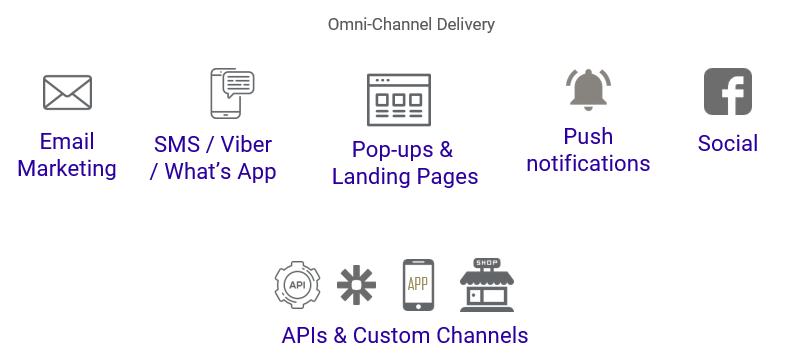
ContactPigeon supports a growing array of channels to engage with your customers.
Organization as a barrier?
Traditional companies are organized by function, and hence, silos form. What does this mean? Usually, physical stores are managed by one team and eCommerce by another while marketing is an entirely different department. This causes monumental challenges and issues when it comes to synchronizing an omnichannel strategy. One suggestion is to organize your company based on customer experience. Similarly, try having one person/team to be responsible for the end-to-end journey.
Also, designing a marketing strategy that will remarket your brand to as many channels as possible is important. The fact is that consumers are increasingly using new channels to shop, from wearables to in-store beacons. Creating an omnichannel marketing channel to address your customers’ needs is vital. It helps you keep your brand valuable and relevant amidst the competition.
Tip: By using a centralized dashboard/reporting/data analytics tool like Google Data Studio you can increase the transparency and visibility of customer and outcome metrics across the functional silos.
An Omnichannel approach is the only way
Omnichannel marketing is the only way to make your eCommerce marketing campaign compatible in 2021. Marketers need to keep up with the natural evolution in eCommerce trends. Buyers want a frictionless, hassle-free shopping experience. At the same time, it is more important than ever that marketers reach their audiences where they shop, such as both online and offline, and using multiple tools. This is the only way to increase your brand’s conversions. Implement your successful omnichannel eCommerce marketing strategy.
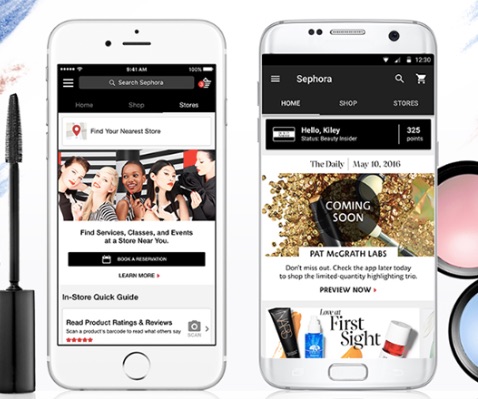
Try some of Sephora’s awesome eCommerce Omnichannel Marketing ideas for your own strategy!
First of all, try out some of the tactics and tools we’ve suggested for your own brand. Start by studying the examples we’ve gone over in this post of brands that nailed their marketing strategies. They have achieved ultimate omnichannel eCommerce performance.
Next, focus on creating a positive shopping experience to convert every new visitor into a sale — either via your website, mobile app downloads, or even brick and mortar store window shoppers. Above all, remember: By harnessing the power of omnichannel marketing with marketing automation, you can engage with your customers like never before. Uber-personally.


